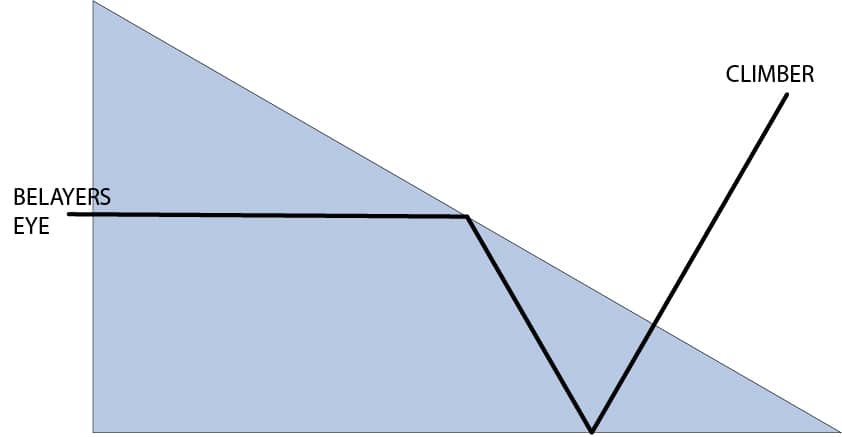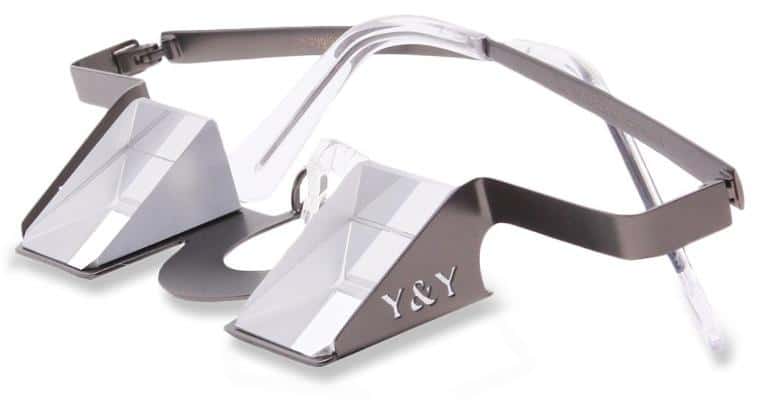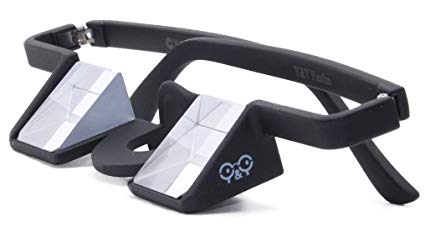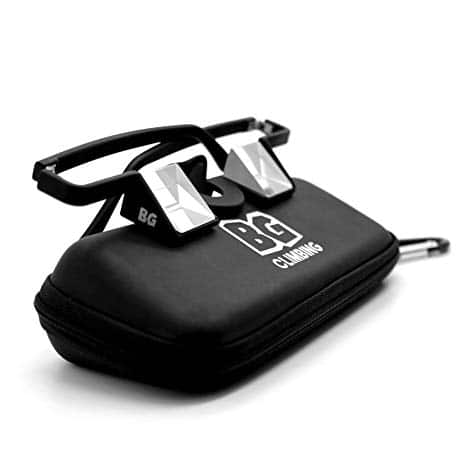Table of Contents
Many pieces of equipment enhance your experience when rock climbing. Are belay glasses worth it? They totally are, they will help you reduce strain and tension in the neck, making belaying more comfortable while still keeping a keen eye on the climber. And that way, they make climbing safer too. I will give you some more details in this post, and some tips on how to use them and get used to them if you try them for the first time.
Some are vital for safety, some more for convenience. Some are critical for both, and some don’t really fit any category. Belay glasses are one peculiar item, where I’m not sure if its just for convenience or also for safety. What belay glasses do is they deflect your field of vision upwards, which means you can belay and keep the climber in your field of view without turning your head up. Keeping a level head helps to reduce neck pain from staring up for long periods. Anyone who has ever belayed for hours on end knows what I’m talking about – stiff neck is a real problem when belaying.
By reducing belayers pain, I would also attribute them to be safety-relevant, as a pain-free belayer is usually more concentrated as well. The working principle of these glasses is straight forward: The image of the climber, which is just light enters the glass, reflects at the bottom mirror to another mirror in front of your eyes and voila, you see what’s above you without tilting your head. Read more here.
The Problem – Stiff neck when belaying
If you ever belayed someone for longer periods of time, or spend your day at the crag you know what I’m talking about. Belaying is a pain in the neck, literally. Even when you are used to it, the constant tilt of the head, to extreme extents when facing high vertical walls, makes your neck stiff and painful. When I started climbing I was a regular patron of physiotherapy.
My neck muscles became really sore and I had major neck cramping after a while. Unfortunately, there is no other option than raising your head – keeping the climber in your eye of view is essential, especially when belaying a lead climber. It’s the first thing you should learn when you learn to belay. Communication and attention to the climber are above all. You need to quickly react if things go south for the person climbing, so when I learned about belay glasses I was stoked, and they worked great for me.
I talked to many other experienced climbers about this, they all told me they suffered from neck strain from time to time. So it’s not like you will get quickly used to it – which is the case for your hands and palms for example, as they have blisters in the beginning but quickly adapt to climbing. Your neck is a different story if anything I noticed it becomes worse or even chronic for some older climbers. It can also lead to migraine and headache, thanks to built-up tension in your neck muscles and tendons.

The Solution
Belay glasses work by reflecting the climber to a mirror in front of your eye, you can keep the climber insight without raising your head constantly. This reduces neck stain you will otherwise suffer and can make a full day of crag climbing and belaying surprisingly easy on your neck. The lenses are made from prism-shaped glasses, which bend the light and lead to total reflection so you always see what the climber does above you.
Use them in most climbing situations, although I recommend them for easier routes where you don’t need to pay very close attention. This is because, in theory, they shouldn’t introduce any distortion, in reality, most glasses do, however. So sometimes it can be nice to not wear them when you need to figure out details on the crag etc. I used to not see a lot of belayers wearing them, then some years ago older climbers started, and nowadays many people in Germany and Europe wear them. While they do look a little funny, they absolutely work and any friend I introduced to them was convinced 100% after a session of using them.
Belay glasses make belaying more comfortable
is of course comfort and for the belayer: your neck position is much more relaxed. This isn’t just for old people, anyone will agree it’s just more comfortable to be looking straight forward than craning the neck up.
Belay glasses make belaying safer
A belayer with pain in the neck, looking away every 10 seconds to have less pain is unsafe. If a belayer can comfortably watch their climber, they are way more likely to keep watching their partner. This way the belayer can do a better job at belaying: He or she can see the climber ready to clip if the climber is about to take a fall etc. This means easier clipping for the climber and less hard catches when lead climbing.
Disadvantages of belay glasses
In theory, the total reflection mechanism used by belay glasses is not distorting your field of view. In reality, most cheaper glasses introduce a little bit of refraction and distortion. That can lead so some dizziness for people not used to wearing belay glasses. This effect usually only lasts a few minutes initially, when your eye adapts to the glass. It’s caused by the way your head movements will affect your field of view when you wear the glasses.
Our eyes are not designed to look through prisms. That’s why it will take some time to map muscle activation to the field of view the belay glasses give you. When you become accustomed to the new way to orient the vision, any previous dizziness tends to disappear. For some people, it can stay, however. If that’s you, get another pair of glasses or don’t wear them. You don’t want to be dizzy while your partner’s life is in your hands or at your belay device.
How to wear them right
Some things to keep in mind when trying belay glasses.
Start out by wearing them without belaying
Get slowly used to them, start wearing them without belaying someone. Deliberately move your head around in different directions and concentrate on how your vision changes. Simulate belaying, that is, without someone actually climbing, position yourself how you would if you were belaying, and keep your eyes fixed to the route. Slowly raise your head as if the climber was making his or her way up, notice how you have to adapt your head movement to the field of vision on the wall. It’s good to try these things before you actually have someone on live belay.
Learn to ditch them quickly
Try out how to quickly don the glasses and get rid of them, in case you need an unreflected field of view
Use a cord
Wear a cord around your neck, this way you can quickly discard of the glasses or don them if you need them
Don’t wear them while the climber is near the ground
I usually try to do a couple of routes without glasses every day. It keeps my muscles somehow activated in the neck, and when it becomes painful I start wearing the glasses to reduce further stress.
Pro tip: Keep the belay glasses around your neck (or lower on your nose) for the first 2-3 clips, where you can still see the climber directly. Then put the glasses on quickly around the third clip or so when it becomes painful to crane the neck up
Know when to not use them
While belay glasses work great for most people you should try them out yourself before you decide to buy. If you don’t know someone who has a pair, try them out in a shop.
Two Good Belaying Glasses
Here are some recommendations for belaying glasses. It’s pretty easy: Go cheap or expensive. The expensive ones are nice if you are serious about these things, offer less distortion, etc. But the cheap ones work well for beginners. It’s up to you and your wallet! I will write a more in-depth review about different belay glasses in the future, but for now, i recommend to stick with the brand Y&Y. They are trusted, work well and affordable.
Y&Y Vertical Glasses
Good pair of belaying glasses, easy to use and frame fits many different noses. The design is minimalistic, and the price is 79$. Get the metal frame, and you can bend it to fit your face.

Y&Y Plasfun Basic Belay Glasses
The cheaper Y&Y glasses, made from plastic but with a good field of view as well. Design is a little larger than the Vertical ones, but the vision works just as well. People with smaller heads might have a problem with the mold piece around the nose, so try them on. Can be found under 50$.

Conclusion
Hope you found this post helpful if you like it leave a comment and make sure to check out some of my other articles like my review of the classic climbing shoe La Sportiva Tarantulace, my DIY portable hangboard setup guide without drilling holes in your apartment, and why you should take your kids rock climbing.

